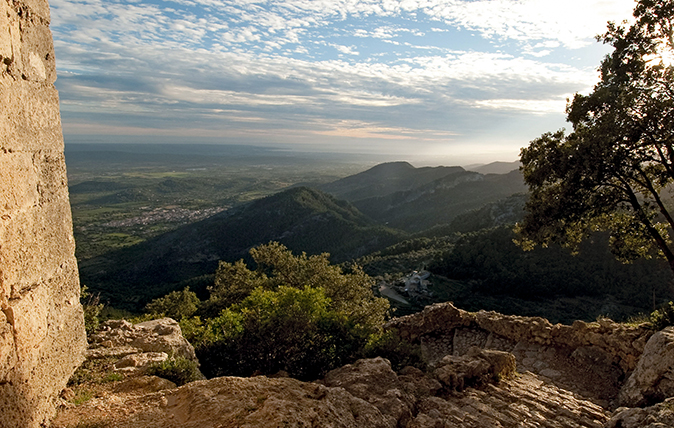The irresistible allure of Mallorca's skies – and the gardens beneath them
David Wheeler is counting down the days until he escapes to the sunshine and beautiful gardens of the Balearics.


Under a duvet of Welsh borderland grey cloud, I’m craving my April return to Mallorca, an island blessed at that time of the year with such a wealth of wild flowers that it seems almost pointless to think about its gardens. However, it’s the gardens I’ll be heading to, reacquainting myself with a sequence of extraordinarily varied places that I’ve come to love in recent times.
Tests on underground water flows reveal the Balearics to be a southern outcrop of the Pyrenees, linked to that mountainous range by deep rivulets running beneath the Mediterranean. Mallorca is the largest of the group and enjoys the widest (and, indeed, wildest) range of landscape diversity. Away from the happily contained budget-airline resorts and the sweep of Palma’s urbanised bay, the island rises and falls dramatically.
The north’s under-populated Serra de Tramuntana—now a World Heritage Site—can be explored by a spinal switchback road through pines and holm oaks; the south-eastern plain is peppered with hamlets and small towns, still bearing exotic architectural references to a history pepped up by ancient Moorish rule.
"Small ivory flowers simultaneously wafting an irresistible scent on the slightest breeze"
Chopin and George Sand spent a winter on the island; Robert Graves lived there for more than 60 years and it continues to be a favoured haunt of European expatriates, kindly invaders who have put down their own tap roots among a native population that has in no way surrendered its Catalan identity. Among the incomers are numerous garden-makers realising their dreams of creating paradise, furnished with unfamiliar plants that would need the costly protection of heated glasshouses in northern climes.
A few of the island's truly inspired and inspiring gardens—private domains, mostly—are so diverse that comparisons are meaningless. The most dramatic of all is the garden made by Heidi Gildemeister, high up on the island’s north-eastern edge where, among fantastical rock formations, a snooker table of verdant tranquillity lies at the heart of a botanical collection of world importance. To wander among its surrounding outcrops, mantled in exuberant euphorbias is to open the pages of a horticultural encyclopedia.

Mrs Gildemeister won acclaim worldwide with her ground-breaking book, Mediterranean Gardening: A Waterwise Approach (1995), which has taught many a rookie gardener how to overcome the foibles of successful cultivation in similarly dry locations. Now, under the auspicies of the Black Vulture Conservation Foundation (yes, Mallorca is for bird-watchers, too), her garden, Torre d’Ariant, combines beauty with learning.
In the south-west, Camilla Chandon’s property, Son Muleta, is equally remote and dramatically situated. An English cottage-garden in Mediterranean garb, you can’t fail to notice that blue dominates the April scene, when its elongated, terraced beds are spiked with cobalt echiums and irises, rising from clouds of cistus, lavender, rosemary and agapanthus.
Exquisite houses, the beauty of Nature, and how to get the most from your life, straight to your inbox.
Majestic olive trees provide welcome shade over sitting areas dressed in mounds of clipped teucrium and box, exclaimed by pencil-thin cypresses and Irish yew. April-flowering climbing roses, pinned to the retaining walls, project intense perfume into an already aromatic cocktail and close inspection of the turfed paths reveals a scattering of myriad wild orchids.
It is said that many of David Austin’s famed English roses thrive in warmer climates. In South Africa and California, his richly yellow rose, Graham Thomas, excels itself. In Mallorca, at Ca’n Estel, away from the hills, an assortment of Austin’s best roses populates vast island beds delineated by wide paths flanked with irises and lavender.
And there’s another delight: citrus. Many kinds are grown at Ca’n Estel, looking as lively as Christmas trees hung with orange and yellow baubles, their small ivory flowers simultaneously wafting an irresistible scent on the slightest breeze.
Return visits to Mallorca seem guaranteed to spring new surprises, new gardens. There are several lined up for my next foray, although the traditional and long-established places have strong allure, too. A recurring dream of mine has, for its backdrop, the extensive wisteria-clad pergolas at the Moorish estate of Alfabia, where someone has made great play with unexpected showers of cooling water, further animating one of Mallorca’s horticultural treasures.
- - -
David Wheeler will host a luxurious Country Life readers’ tour to Mallorca’s finest gardens this spring, from April 23 to 28. Price per person: £3,850. Single supplement: £490. The price includes accommodation at two five-star hotels, all visits and transportation on the island, all evening meals with local wines, plus five lunches and return flights from London Heathrow. For further information and to book, contact Boxwood Tours via their website or on 01341 241717.
Country Life is unlike any other magazine: the only glossy weekly on the newsstand and the only magazine that has been guest-edited by His Majesty The King not once, but twice. It is a celebration of modern rural life and all its diverse joys and pleasures — that was first published in Queen Victoria's Diamond Jubilee year. Our eclectic mixture of witty and informative content — from the most up-to-date property news and commentary and a coveted glimpse inside some of the UK's best houses and gardens, to gardening, the arts and interior design, written by experts in their field — still cannot be found in print or online, anywhere else.
